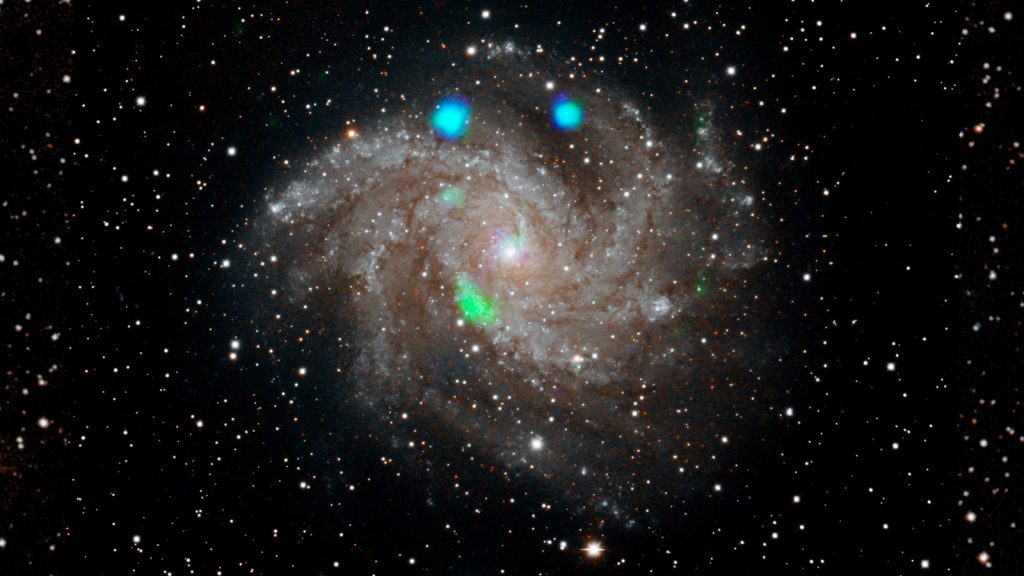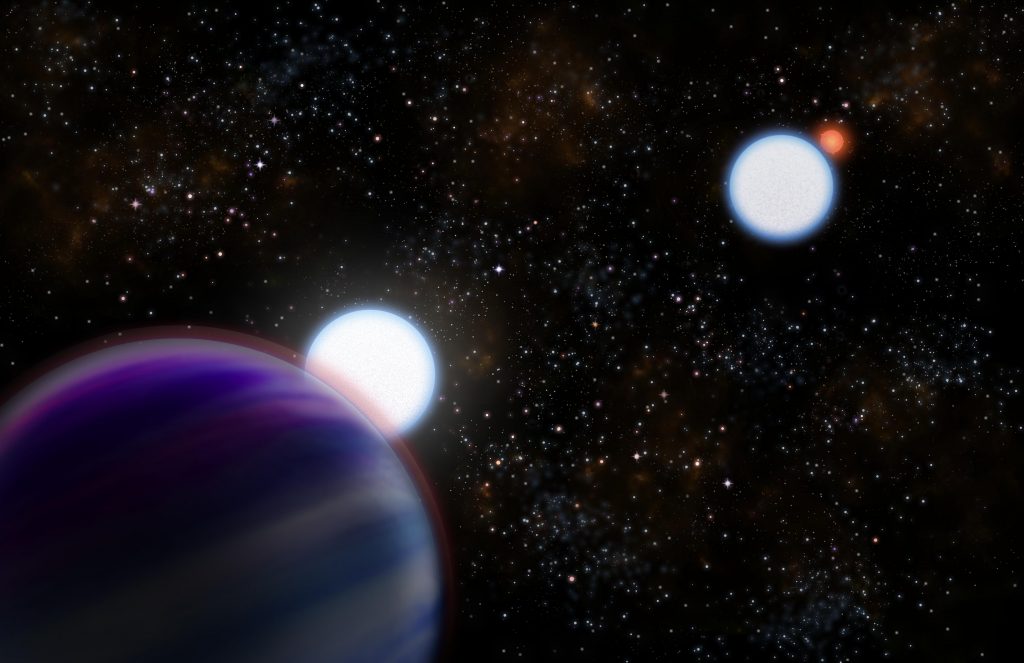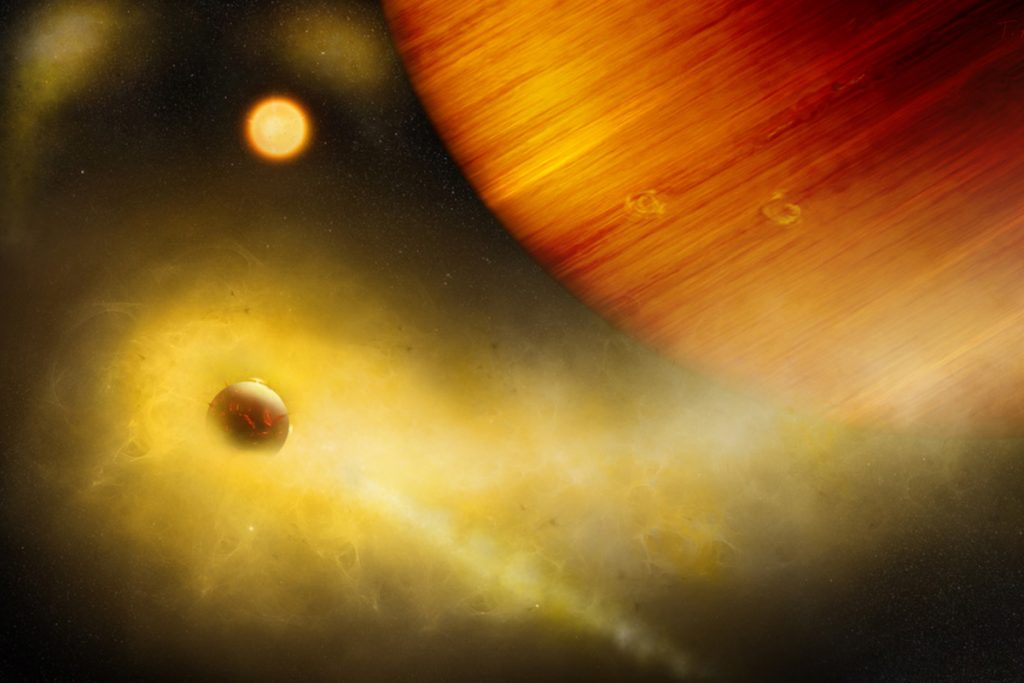
In this inaugural episode of the Daily Space, we take a look at an X-Ray source that rapidly appeared out of no where to photobomb images of a fading Supernova, and the creative solutions astronomers have found to to understand both a planet in a the tight binary Kepler-13AB and to find a volcanic exomoon.
Links
Photobombing Ultra Luminous X-Ray Source
- NASA Satellite Spots a Mystery That’s Gone in a Flash (press release)
- A broadband look at the old and new ULXs of NGC 6946 (arXiv)
Missing Planetary Potassium Revealed
- Chemical element potassium detected in an exoplanet atmosphere (press release)
- The potassium absorption on HD189733b and HD209458b (MNRAS)
The Case of the a Planet in a Close Binary Star System
- Exoplanets Can’t Hide Their Secrets from Innovative New Instrument (press release)
- High-resolution Imaging Transit Photometry of Kepler-13AB (AJ, paywall)
Finding Volcanic ExoMoons
- Hints of a volcanically active exomoon (press release)
- Sodium and Potassium Signatures of Volcanic Satellites Orbiting Close-in Gas Giant Exoplanets (arXiv)
Transcript
This is the Daily Space for today, Thursday, September 5, 2019.
Welcome to the first episode of our new podcast edition of the Daily Space, I am your host, Dr Pamela Gay, and I am here to put science in your brain. Most Mondays through Fridays either I or my co-host Annie Wilson will be here, bringing you a quick run down of all that is new in space and astronomy.

Credit: NASA/JPL-Caltech
In today’s first story, we bring you news from NuSTAR, an X-Ray observatory launched back in 2012 that lets astronomers see events that release high energy photons of light. Back in 2017, NuSTAR performed two sets of observations, 11 days apart, to study supernova 2017eaw. During the second set of observations, a surprising object photobombed their data. To everyone’s surprise a new bright X-Ray source had appeared – one that wasn’t linked to any visible light source, such as our eyes could see. This new source was unusual both for its lack of visible light – such as would be produced in a supernova explosion – and in how rapidly it appeared.
According to Hannah Earnshaw, a CalTech researcher and lead author of this study, “Usually with NuSTAR we observe more gradual changes over time. In this instance, we were fortunate to catch a source changing extremely quickly, which is very exciting.” Using just the data on-hand, it is potentially impossible to know exactly what caused this sudden appearance of a bright source of X-ray light. Possibilities include it is a blackhole shredding apart an object that got to close, or that we’re seeing glitch or waver in a neutron stars magnetic field that allowed material to fall to its surface in a high-energy X-ray emitted explosion. Future observations of recurring X-ray emissions may help, since a neutron star could repeatedly give off this kind of a flare. The answer is unlikely to ever be certain, but w hen we’re observing objects the size of Manhattan island or smaller, that are located 22.5 million light years away, saying “This is most likely a neutron star” is still a pretty amazing accomplishment.

From distant galaxies to not so distant exoplanets, our next story takes us to HD189733b, one of the best studied hot Jupiters on record. This not so little world orbits a star located 64 light years away. It’s orbit is 30 times smaller than our own Earth’s orbit around the Sun and each of its years are just 53 hours long. With this close a proximity to a star, this Gas Giant has a surface temperature of a few thousand degrees Kelvin. At these temperatures, elements like sodium and potassium are vaporized, and should be visible in planetary atmospheres. While sodium has been seen many times, potassium had so far eluded detection. The key word here is “had.” In a new study led by PhD student Engin Keles, researchers using the Large Binocular Telescope have finally found this elusive atom. The Large Binocular Telescope is made of two 8.4 meter mirrors that are mounted together to act as a single, binocular system. Using the Potsdam Echelle Polarimetric and Spectroscopic Instrument, or PEPSI, on this telescope allowed astronomers to see the planet’s atmosphere as never before.
Studying planetary atmospheres isn’t easy. To get useful data, astronomers have to look at the atmosphere as the planet passes in front of its parent star, and then carefully look at how that star light interacts with the atmosphere in ways that signify the presence of different elements. Delicate features can get lost in the stars light, and any noise in the data can obscure the presence of hard to see elements. Beating down this noise is what the Large Binocular Telescope, and it’s two large mirrors has done, allowing the future Dr Keles to verify that 20 year old theories about planetary atmospheres were accurate.
From planetary atmospheres we jump to two different stories that each involve three-body problems.

Credit: Gemini Observatory/NSF/AURA/Artwork by Joy Pollard
There is only one solvable form of the three-body or many-body problem, and this involves a systems where smaller objects orbit one of two larger objects, and can be treated in most regards as part of the object they are orbiting. This is the situation we see in binary star systems where the planets go round and around their parent star, and the stars go round and around each other, and things can be calculated pretty easily… at least this is the case if you know which star the planets are circling.
In the case of binary system Kepler-13AB the exact configuration of planets and stars has been a bit of a mystery. The Kepler space observatory detected planets by looking for the lighting dimming of starlight that occurs when a planet passes between us and the star it is orbiting. In the case of close binary systems like Kepler-13AB, what we say was the combined light of these two close together stars dimming, but it wasn’t to see the light from each star separately, and least not until now.
New instruments launched on the Gemini North and South telescopes now allow high speed speckle imaging to be performed. By taking rapid fire images, these instruments eliminate the normal blur our planet’s atmosphere creates in astronomical images. This is the same technique made famous when it was used to measure the stars orbiting our galaxy’s super massive blackhole.
Named ‘Alopeke (a contemporary Hawaiian word for Fox) the Gemini North speckle imager was able to separate the light from Kepler 13A and Kepler 13B, and with just 4 hours of data, the team can now say with certainty that there is a planet orbiting Kepler 13A. By observer simultaneously in both red light and blue light, they were also able to see that this planet is bright in the red colors that indicate it is likely a hot Jupiter with a bloated out atmosphere.
While this is the first published system to have its three-body confusion sorted this way, it won’t be the last. These imagers are now ready to be set loose solving all the binary stars found by new missions like TESS, and sitting in the Kepler data set.

© University of Bern, Illustration: Thibaut Roger
In our final story of the day, we bring you a more challenging version of the three-body problem. In systems consisting of objects of three very different masses, it’s possible for the smallest object to get ejected unless there is a mechanism to stabilize its orbit. This kind of effect can happen to the moons of Hot Jupiters unless something can be done to add stability. Early work in 2006 suggested that tidal forces could drive volcanic activity, and the moon could eject vast amounts of material while remaining in a stable orbit for billions of years. The nice thing about this kind of a prediction is it has observables – if a moon experiencing extreme volcanism, we should see sodium and potassium that would form a ring surrounding the planet.
By combining previously-published results with new computational models, a team led by Apurva Oza looked at a myriad of different hot Jupiters to see which ones observationally match what is expected if there is a volcanic exomoon. Of all their candidates, WASP 49-b was a clear stand out. This planet orbits its star roughly every 3 days and is located 550 light years away from Earth. On its tiny orbit, the expected sodium was detected, and the model and reality lined up in a way that makes it appear we have found our first explosively volcanic moon. We don’t know how common this kind of a system is, but now we know how to find them.
It is rare that we get to say, “This cool thing was theorized and now we see it.” To have two such stories in one day is kind of amazing, and our virtual hats are off to the amazing theorists and observers whose combined efforts are revealing more about our universe every day.
And that rounds out our episode for today. This has been the Daily Space. We’re new, and we could really use your help getting the word out. If you liked this episode, please subscribe and then encourage your friends to subscribe! We would also really appreciate it if you’d take a minute to leave us a review on iTunes or your favourite podcast directory.
The Daily Space is brought to you by CosmoQuest and is produced by the Planetary Science Institute, a 501(c)3 non-profit dedicated to exploring our solar system. We are made possible through the generous contributions of people like you. If you would like to learn more, please check us out on patreon.com/cosmoquestx


 We record most shows live, on Twitch. Follow us today to get alerts when we go live.
We record most shows live, on Twitch. Follow us today to get alerts when we go live.
Trackbacks/Pingbacks